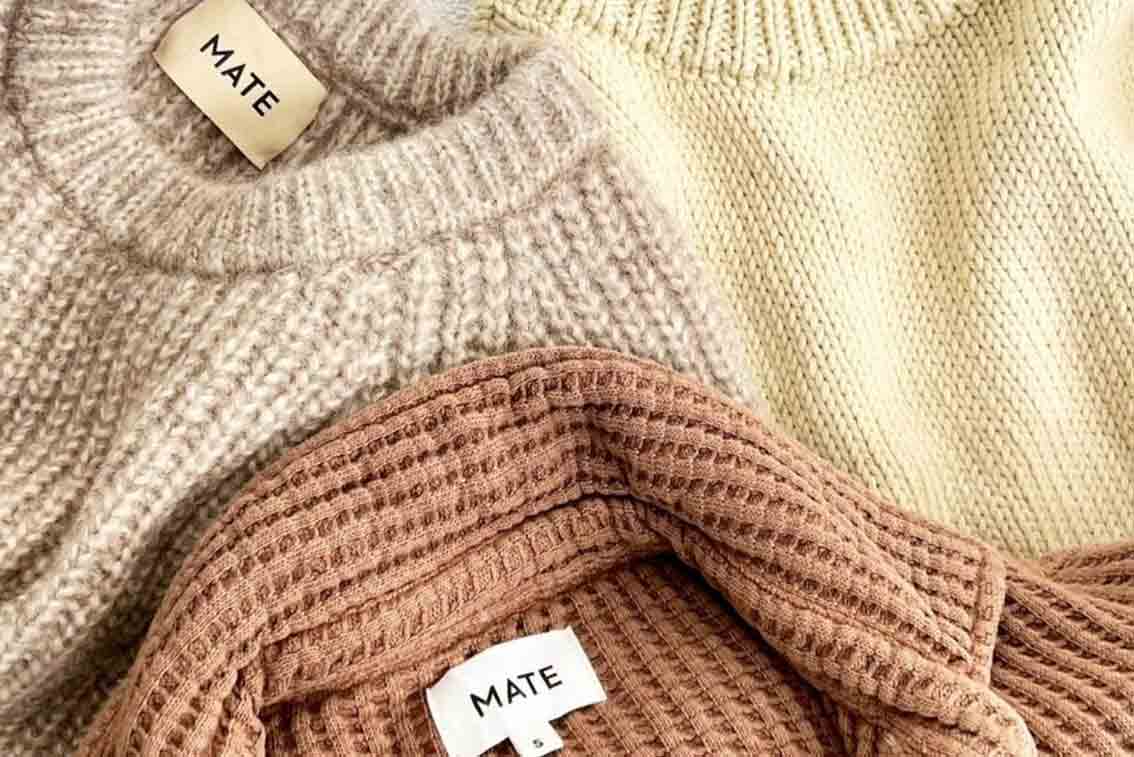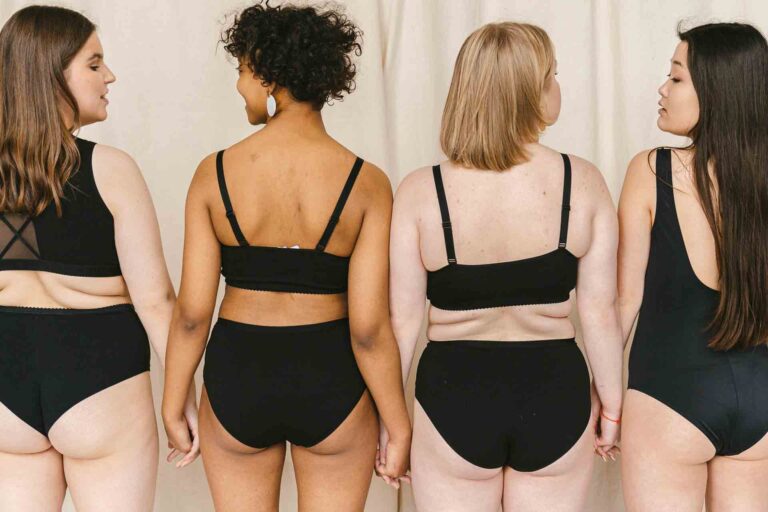Did you know that 24% of global insecticide usage comes from the fashion industry?
Among one of the worst offenders is cotton, often dubbed the “world’s dirtiest crop,” for that very reason.
Luckily, there are clothing options that don’t share in this dirty secret. MATE The Label is one such company that says they use organic cotton and other eco-friendly materials. Yet, the question remains: does MATE the Label live up to their claims?
Today, we’ll examine their sustainable and ethical standards and discuss any shortcomings to fully answer the question: is this a brand we should support or skip?

Who is MATE The Label?
MATE the Label was founded by Kayti O’Connell Carr, who initially began by making vintage-inspired T-shirts under the brand name “Mate.” However, as the journey unfolded, Kayti became acutely aware of the waste generated in the clothing industry, even for a single t-shirt.
And with that, she was inspired to create high-quality garments in a responsible manner: MATE the Label was born.
Product Line
MATE the Label crafts a diverse range of clothing basics using non-toxic, natural, and organic materials. Their product line spans across various categories, catering to women, men, and kids.
Within their collection, you’ll discover an array of casual and comfortable apparel, including sweats, tees, tanks, activewear, intimates, and sleepwear.

Is MATE the Label Sustainable?
When assessing a brand’s sustainability, we explore various facets, including transparency in its supply chain, resource conservation efforts, material choices (organic, recycled, toxin-free), sustainable packaging practices, and initiatives to minimize waste throughout a product’s lifecycle.
Supply Chain Transparency
MATE the Label’s manufacturing operations take place within a 15-mile radius of their Los Angeles office.
This proximity allows them to maintain close oversight and ensure sustainable methods are followed. However, they rely on importing yarn to make the garments from overseas, and here the transparency becomes murkier.
Despite this, MATE the Label actively strives for improvement. Their participation in the California Cotton & Climate Coalition (C4) signifies a commitment to promoting California-grown cotton and fostering regenerative farming practices in collaboration with local farmers.
This endeavor will hopefully lead to better and more holistic supply chain transparency and sustainability.
Resource Usage
MATE the Label adopts a commendable approach by relying on local manufacturing in Los Angeles.
This decision significantly reduces transport emissions, as everything they create is made within a 15-mile radius of their Los Angeles office. While organic yarn is transported from overseas (typically India), the majority of production occurs locally, minimizing their carbon footprint.

Materials
When it comes to materials, MATE the Label showcases a commitment to sustainability and health. They uphold strict guidelines regarding chemicals and dye substances, restricting the use of 31 chemicals and 49 dyes in their clothing. For instance, they avoid azo dyes, known for their potential carcinogenic and allergic reactions.
The brand primarily employs organic cotton and organic linen, both natural fibers grown without pesticides or harsh chemicals. Additionally, they incorporate Tencel Lyocell, a sustainable semi-synthetic material created from natural fibers, rather than plastics.
To provide stretch to some garments, they use an Organic Stretch fabric composed of 8% spandex and the rest organic cotton, offering an eco-friendly alternative to traditional synthetic stretch fabrics.

Packaging Sustainability
MATE the Label takes sustainability beyond the clothing itself, eliminating all plastic from labels and packaging. Instead, they utilize recycled and compostable packing slips, aligning their packaging practices with their eco-conscious values.
Product Lifecycle
MATE the Label’s commitment to sustainability extends to the product lifecycle. They operate a recycling program, accepting old garments and transforming them into new MATE products.
Additionally, they collect scraps from factories, repurposing them into new MATE products through a mechanical fiber recycler.

Is MATE the Label Ethical?
When evaluating a brand’s ethical practices, we delve into how they treat their workers, uphold labor rights, ensure fair wages, maintain good working conditions, and demonstrate concern for animal rights and social impact.
Worker Treatment and Labor Rights:
MATE the Label forges strong partnerships with local Los Angeles garment workers. The final stages of production occur within a mere 15 miles of their office, granting them the ability to ensure that their garment workers receive not only fair treatment but also fair wages. This commitment to local workers speaks to their dedication to ethical manufacturing.
Supply Chain Transparency:
While MATE the Label excels in supporting its local workforce, challenges regarding transparency arise in their overseas supply chain.
Despite their commendable use of organic fabrics, which typically lead to better conditions for farmers due to the absence of harmful pesticides, there’s room for improvement in clarifying the supply chain before it reaches Los Angeles. However, it’s worth noting that MATE the Label is actively working on enhancing transparency, as evidenced by their partnership with the California Cotton & Climate Coalition (C4).
Animal Rights:
In the realm of animal rights, MATE the Label proudly stands as a beacon of ethical fashion. Their commitment to being entirely vegan aligns with their dedication to treating animals fairly and with respect
Key Takeaways
So, Support or Skip?
The decision to embrace or skip a brand hinges on various factors. In the case of MATE the Label, their commitment to local manufacturing and ethical treatment of workers close to their Los Angeles office is commendable.
Additionally, their strong focus on organic and sustainable materials, from the textiles, to the dyes, to the packaging materials, makes this a brand you can be proud to support as a sustainable option for your wardrobe essentials.
What Could Improve?
While MATE the Label excels in many aspects, there are areas with potential for enhancement.
Supply chain transparency remains less certain for their overseas operations, and there’s room for improvement in clarifying this aspect. Knowing this is an areas they are actively working on improving, I’m excited to see how they advance in coming years.
Final Thoughts
MATE the Label embodies many aspects of ethical and sustainable fashion that resonate with conscious consumers. Their commitment to responsible practices and their ongoing efforts to improve are encouraging signs, making them a great option to support and avoid fast fashion brands.
By supporting MATE the Label, you align yourself with a brand dedicated to making a positive impact on the fashion industry.
FAQ
What is organic clothing?
Organic clothing refers to garments made from materials that are grown without the use of synthetic pesticides, herbicides, or genetically modified organisms (GMOs). It encompasses a wide range of fibers, including organic cotton, hemp, bamboo, and wool.
These textiles are produced using environmentally friendly farming practices that prioritize soil health, water conservation, and reduced chemical exposure. Read more about the differences in natural fiber and organic clothing, how to identify it, and how to properly care for your garments here.
How was this research conducted?
The information in this article came from reviewing the brand’s website, policies and sustainability reports, and took into account the brand’s sustainability rating information given by Good on You. Using this information, I pulled from my knowledge of sustainable design & manufacturing to identify areas of importance.







